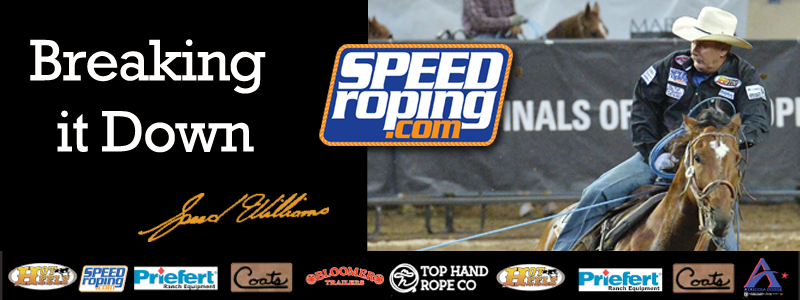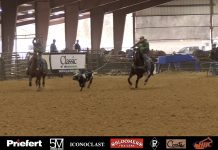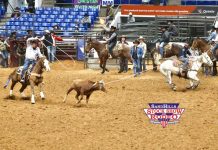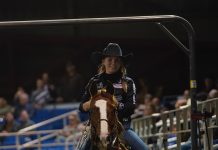Head Horses Getting Strong in the Corner

Recently I’ve purchased a few really nice-looking big and stout head horses. Their owners were not getting along with them because they were ducking hard and felt out of control.
There are many reasons head horses start getting strong in the corner. You need to figure out whether it’s the saddle, the pads, or maybe pilot error where the rider is squeezing with the right leg and leaving the left leg open. Possibly it’s because they’ve roped big steers that got heavy and the horse is trying to get ahead of the jerk.
Low number headers often unintentionally use the bridle reins for balance. This teaches your horse to run through the bridle, meaning they don’t respond when you pull on them and they have to “run through your hand” to get to the cow. When you engage your bridle reins your horse should not get closer to the cow. He should be slowing down. If you have contact with the reins and are pulling, you should be getting further away from the cow.
I see it sometimes when I video my clients. They engage the reins when they’re still 20 feet from the cow. The horse continues to run and has learned to run through the bridle to get to his spot. This results in your horse having a “hard mouth” and teaches him not to respond.
When you slow a video down and watch it frame by frame, pilot error becomes obvious. You can see everything that’s happening during a team roping run. It’s much easier to see if the riders’ legs and hands are in the correct position.
When Dustin Egusquiza started coming over a few months ago, I put him on the Speed Trainer. When he was reaching he looked outstanding. But up close he really struggled with trying not to light it up using the bridle reins. Up close he was actually splitting the horns because he had never really worked on his close game much. It sure didn’t take him long to figure out how to kick with one leg and rope in under two seconds without lighting it up. But in the beginning he made the buzzer go off a lot.
As an instructor who gives lessons as a profession, it’s been incredibly exciting to show people how to improve their roping and go through all the steps correctly while sitting still. Sitting still on the Speed Trainer, they are able to concentrate and isolate what they need to work much easier and faster. Then, when they get on their horse it’s easier to use their left leg and not pull on the reins when they don’t need to. I’m not saying you don’t ever need to engage the reins, but make sure you’re pulling out of necessity and not out of habit.
It’s very hard to improve your roping if your left hand and your feet are not helping you ride and control your horse properly. This also affects heelers and it’s just as important they use their left hand and legs correctly.
What’s new with me: A few years ago, we sold our place in DeLeon, Texas and moved to Center, Texas to work with Terry Bailey who built an unbelievable roping and equestrian facility. Terry later had a fatal accident in his helicopter. Two weeks after closing on our place in DeLeon we were homeless and moved to Orange, Texas and stayed with Chad Havens for a few months before Hurricane Harvey hit. It was then Roy Gene Evans called my wife and offered to lease us his indoor arena in Santo, Texas. We’ve taught lessons there for close to two years while looking for a place of our own. Thanks to the generosity of these two friends, it gave us time to look for a home. We were fortunate to close on 70 acres in Comanche, Texas with a house, hay barn, ten pastures, coastal field, and lots of water, grass, and trees – and sand like Florida. We finally found a place to call home and all four of us love it. I want to thank my wife for being patient because I took my time looking. We looked at many places and found a couple but ultimately they fell through for one reason or another. I think this is the place we were meant to find and we’re happy to be home.






